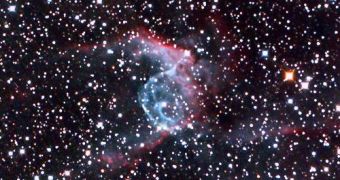A combination of effects produced by a dying Wolf Rayet-type star and its surrounding interstellar matter is responsible for the creation of a very interesting nebula in space, called Thor's Helmut.
This object is somewhat unusual, astronomers say, because its core is powered by a giant star that is currently very hot. The object was possibly caught in the very brief period of time that marks its transition from a massive star to a supernova event.
Scientists say that this pre-supernova stage of stellar evolution usually doesn't last long, and that this nebula will not continue to look the way it does today for a long time.
Among the most interesting features that make Thor's Helmut stand out from the crowd is the fact that it features a complex shape, alongside a curved bow-shock structure, both of which are the result of the aforementioned interactions.
The object is located about 15,000 light-years away from Earth, which is basically in our backyard, in astronomical terms. This nebula extends for about 30 light-years, Universe Today reports.
Chief among the reasons it looks the way it does is the interaction that occurs between the Wolf-Rayet star at its core and a warm, large and dense molecular cloud that can be found nearby.
The central star is producing a lot of high-velocity winds, which slam into surrounding matter and push it away. As a result, the ring-like shell around the nebula is both expanded and compressed at the same time, experts say.
“We have detected three different velocity components, and determined their spatial distribution and physical properties. The kinematics, morphology, mass and density are clearly stratified with respect to the W-R star.” says JR Rizzo, the leader of the new research.
“These features allow us to learn about the recent evolutionary history of HD 56925, because the multiple layers could be associated to several energetic events which have acted upon the surrounding circumstellar medium,” he adds.
“Hence, a careful study of the different shockfronts contain clues in determining the present and past interaction of this evolved massive star with its surroundings,” Rizzo goes on to say.
The star at the core of Thor's Helmut (NGC 2359) is very young, unlike the older giants that can be found in other types of planetary nebulae. Being a Wolf Rayet-type star, its surface temperatures can grow to reach ~50,000 Kelvin.
“The overall emission in the nebula is dominated by the overwhelming contribution of the H II region and is characteristic of photoionization processes,” explains scientist TE Jernigan.
“In NGC 2359, imagery reveals variations in density, temperature, and ionization structure on scales ranging from the size of the nebula down to the seeing limit of approximately 2.1 seconds,” he adds.

 14 DAY TRIAL //
14 DAY TRIAL //